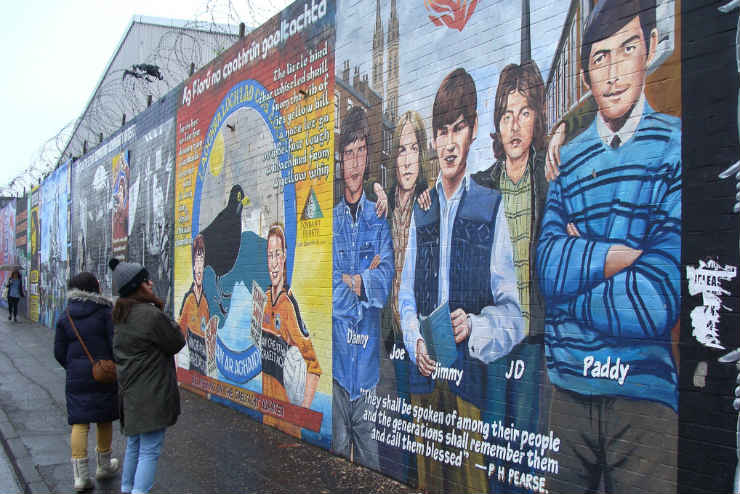Why Belfast is a city reborn
World-class gastronomy, exciting nightlife and a wealth of historical attractions have put Belfast on the map. Andrew Doherty discovers a city on the cusp of a renaissance.
Techno music throbs as throngs of revellers wrapped in rainbow flags dance and embrace around me. I’ve wandered into the path of the Belfast Pride celebrations, and the streets outside City Hall are packed with thousands of supporters.
Suddenly, a troop of police officers appear, uniforms in stark contrast to the sea of colour. This is the second year that the police have marched at Pride, demonstrating their commitment to promoting inclusiveness and diversity. As they pass I glimpse an officer hugging a bearded dancer in six-inch heels and silver hot pants.
It’s a long way from the dark days of the Troubles and a fantastic start to my Belfast trip, the city I once called home.
A city reborn
With its hotel openings, a new public bus service and a host of chic restaurants and bars, Belfast feels like a different place to the one I left five years ago.
The Grand Central, Belfast’s newest luxury hotel and my base for the weekend, features 300 rooms and 10 suites with stunning views of the city. I ride the lift to the 23rd-floor Observatory bar to sample a few cocktails, all of which are named after city landmarks, such as the Belfast Castillo – a toasted coconut, yellow chartreuse and charred pineapple sherbet concoction.
Belfast is famed for the “craic”, with plenty of bars and clubs in and around the city centre. Music fans should check out the Limelight for live gigs, Thompsons Garage where electronic music is the name of the game and Kremlin, one of the best known gay bars in Northern Ireland.
From the humble Ulster fry, Northern Ireland’s traditional full breakfast, to a swathe of high-end dining options, clients will certainly eat well here. I wander down to Cathedral Quarter, home to some of the city’s best restaurants, to feast on steak in Hadskis, a charming but unpretentious eatery housed in a 1760s iron foundry, before ending the evening with a nightcap in the Crown Liquor Saloon. The iconic pub has hardly changed since the 1800s and tourists scramble for a coveted spot in one of its 10 Victorian snugs.
Sipping my perfectly poured pint of Guinness, I feel an overwhelming sense of pride for Belfast and how it has progressed, and I’m keen to discover more of its highlights.
History buffs
Belfast, meaning “mouth of the sandbanks” in Irish, is the largest city in Northern Ireland. Occupied since the Iron Age, the city thrived in the 19th century with the industrialisation of its linen, tobacco and shipbuilding trades.
A 10-minute taxi ride from the centre sees me at Titanic Belfast – an impressive tribute to the ill-fated cruise liner that struck an iceberg and sank in 1912, having set off on its voyage from the Northern Irish city.
The attraction extends across nine interactive galleries, using artefacts, exhibits and CGI to chronicle the city’s thriving industries and the innovations that led to the construction of the Olympic-class ocean liner.
From a life-size model of a first-class cabin to the stories of individuals that perished onboard, the attraction makes for a fascinating, yet haunting experience.
Heading outside, I board Titanic’s original tender ship and the world’s last White Star vessel, SS Nomadic, situated outside the museum in dry dock.
After extensive renovations carried out in 2012, SS Nomadic looks as it did in 1911, with recreations of original furniture, the engine room and even a first-class champagne bar complete with hologram waiter who scolds me in a thick French accent for having the audacity to approach with a third-class ticket!
Dark days
While “Linenopolis”, as Belfast was nicknamed in the 19th century, enjoyed a period of prosperity brought with its heavy industry, the Troubles saw the good times abruptly end. This 30–year conflict between Protestant unionists, who wanted to remain in the UK, and Catholic nationalists, who believed in a united Ireland, saw more than 3,600 people killed in attacks carried out by paramilitary and security forces.
Growing up in Northern Ireland during the 90s, I’m lucky to have no first-hand experience of the conflict, so I join city guide Dee Morgan to learn about what life was like during the height of the violence. A Belfast native, Morgan grew up in the 70s in the midst of the chaos, often disobeying her parents to travel into the heavily bombed city centre.
“I used to come home with ripped jeans all the time,” she laughs. “All we’d have to do is say our name to get chased [locals can often tell who’s Catholic or Protestant by their first name]. There were lots of times I had to scale a barbed wire fence to escape.”
From the back of our tour bus, Morgan points out several large murals. These arresting depictions of the Troubles include tributes to republican hunger striker Bobby Sands, balaclava-donned sectarian fighters and a “solidarity wall” that includes a recreation of Picasso’s Guernica.
We also pass the city’s most famous sights – the Grand Opera House where Pavarotti performed in the 1960s, Botanic Gardens which is home to a Victorian palm house and tropical ravine and the Crumlin Road Gaol.
The tour culminates with a visit to the Cupar Way “peace wall” that divides the Protestant Shankill Road from the Catholic Falls Road.
“People have been leaving signatures and writing messages on the wall since the peace agreement in 1998,” says Morgan. “Obama and Clinton have visited to share their thoughts, and Justin Bieber came too. Although he just scribbled ‘Bieber’,” she chuckles. I take a permanent marker, find an inch of space and try my best to summarise my feelings on how
Belfast has changed for the better. I find a quote from Northern Irish rockers Asiwyfa sums it up: All Hail Bright Futures.
Book it: Grand Central Hotel offers nightly rates from £190pp. Stena Line has fares from Liverpool to Belfast from £89 for a single car and driver.
grandcentralhotelbelfast.com
stenaline.co.uk
60. Seconds With...
Howard Hastings managing director, Hastings Hotels
WHAT ROLES HAVE YOU PLAYED IN TOURISM?
I was on the board of Tourism Ireland when it was set up and, more recently, I had a six-year spell as chairman of Tourism Northern Ireland. It was during my tenure that we worked on the Titanic Belfast attraction.
WHY SHOULD PEOPLE VISIT NOW?
Northern Ireland is an authentic destination. We have a number of great events throughout the year and the Game of Thrones connection too. Belfast now welcomes two million overnight guests and we’re fast approaching 200,000 cruise passengers a year.
HOW DID THE GRAND CENTRAL PROJECT HAPPEN?
This is our seventh hotel in our portfolio and the second in the capital. This was a slightly unloved part of Belfast, filled with semi empty government tenements. Already, you can see how the hotel is animating the district.
WHAT’S THE CITY’S BEST-KEPT SECRET?
I would recommend a visit to St George’s Market where the locals hang out. They know it’s the best place to get your breakfast on a Saturday morning. You get a real sense of Belfast when you go down there.


















